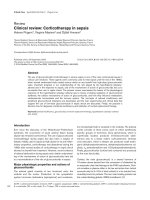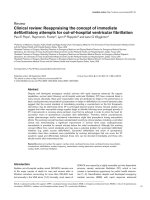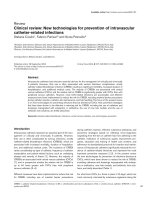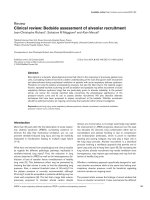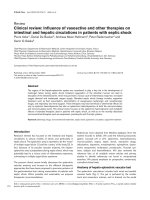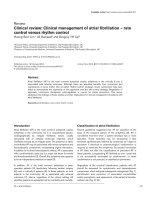Báo cáo khoa học: "Clinical review: Aggressive management and extracorporeal support for drug-induced cardiotoxicity" potx
Bạn đang xem bản rút gọn của tài liệu. Xem và tải ngay bản đầy đủ của tài liệu tại đây (250.57 KB, 8 trang )
Page 1 of 8
(page number not for citation purposes)
Available online />Abstract
Poisoning may induce failure in multiple organs, leading to death.
Supportive treatments and supplementation of failing organs are
usually efficient. In contrast, the usefulness of cardiopulmonary
bypass in drug-induced shock remains a matter of debate. The
majority of deaths results from poisoning with membrane stabilising
agents and calcium channel blockers. There is a need for more
aggressive treatment in patients not responding to conventional
treatments. The development of new antidotes is limited. In
contrast, experimental studies support the hypothesis that cardio-
pulmonary bypass is life-saving. A review of the literature shows
that cardiopulmonary bypass of the poisoned heart is feasible. The
largest experience has resulted from the use of peripheral
cardiopulmonary bypass. However, a literature review does not
allow any conclusions regarding the efficiency and indications for
this invasive method. Indeed, the majority of reports are single
cases, with only one series of seven patients. Appealing results
suggest that further studies are needed. Determination of prog-
nostic factors predictive of refractoriness to conventional treatment
for cardiotoxic poisonings is mandatory. These prognostic factors
are specific for a toxicant or a class of toxicants. Knowledge of
them will result in clarification of the indications for cardio-
pulmonary bypass in poisonings.
Introduction
Failure of various organs may result in the death of acutely
poisoned patients. In the 1960s, sedative-induced respiratory
failure was the leading cause of death in Western countries.
In these cases, endotracheal intubation and mechanical
ventilation dramatically improved the prognosis. Similarly,
renal replacement therapy with dialysis prevents deaths
related to toxicant-induced acute renal failure. Even drug-
induced fulminant liver failure is successfully treated in
selected cases by liver transplantation. In contrast, the
usefulness of temporary mechanical assistance in drug-
induced cardiac failure still remains a matter of debate [1,2].
However, promising results have been obtained using a
combination of percutaneous cardiopulmonary support and
cardiac resuscitation [3,4]. Furthermore, a recent report of
the first series of acute poisonings treated with extra-
corporeal life support (ECLS) [5], together with an increasing
number of case reports [6-10], suggests it is necessary to
define the place of this aggressive treatment for drug-induced
cardiotropic toxicity.
Drug-induced cardiovascular shock: a leading
cause of death
Over the past 30 years, improvements in the treatment of
drug-induced cardiovascular shock have been due mainly to
a better understanding of the different mechanisms of shock.
Routine bedside haemodynamic examinations have provided
evidence of the different mechanisms of drug-induced cardio-
vascular shock, which has enabled the selection of drugs to
address the different components of shock. Within the same
period of time, indications for mechanical ventilation were
extended to conscious poisoned patients presenting with
severe cardiovascular shock. Consequently, the prognosis of
some cardiotropic drug poisonings improved. Indeed, in a
prospective study with historical controls, the combination of
epinephrine, diazepam and mechanical ventilation
significantly improved the outcome of previously fatal
chloroquine poisonings [11,12].
In addition to supportive treatment, a number of antidotes and
specific treatments have been investigated (Figure 1). Among
cardiotoxic drugs, however, only one antidote, digitalis-
specific Fab fragments, has succeeded in improving the
prognosis of digitalis poisoning. Digitalis-specific Fab
fragments are highly efficient and should now be considered
as first-line treatment for this formerly deadly poisoning [13].
Review
Clinical review: Aggressive management and extracorporeal
support for drug-induced cardiotoxicity
Frédéric J Baud
1
, Bruno Megarbane
1
, Nicolas Deye
1
and Pascal Leprince
2
1
Medical and Toxicological Intensive Care Unit, Assistance Publique-Hôpitaux de Paris, University Paris 7, Hôpital Lariboisière, 75010 Paris, France
2
Department of Cardiovascular and Thoracic Surgery, Assistance Publique-Hôpitaux de Paris, University Paris 6, Hôpital Pitié Salpétrière, 75013 Paris,
France
Corresponding author: Frédéric Baud,
Published: 12 March 2007 Critical Care 2007, 11:207 (doi:10.1186/cc5700)
This article is online at />© 2007 BioMed Central Ltd
AAPCC = American Association of Poison Control Centers; ACLS = advanced cardiac life support; CPB = cardiopulmonary bypass; ECLS =
extracorporeal life support; ECMO = extracorporeal membrane oxygenation; IABP = intra-aortic balloon pump; MSA = membrane stabilising activ-
ity; SSRI = selective serotonin reuptake inhibitor.
Page 2 of 8
(page number not for citation purposes)
Critical Care Vol 11 No 2 Baud et al.
There is no further need for anti-arrhythmics, endocardial
pacemakers or even ECLS, which had been used in the past
[14,15], providing that digoxin-specific Fab fragments are
available [15]. However, the future of immunotherapy in the
treatment of other cardiotoxic drug poisonings still remains
uncertain. Desipramine-specific Fab fragments were shown
to be efficient in experimental models [16,17] but the
conclusion of clinical trials is still pending [18]. Similarly,
colchicine-specific Fab fragments were also shown to be
efficient in experimental models [19-23] but only one life-
threatening human case has benefited from this treatment
due to a shortage of specific Fab fragments [24].
In spite of treatment improvement, drug-induced cardio-
vascular failure still remains a leading cause of death. Among
847,483 poisonings in adults over 19 years of age, cardio-
vascular drugs were involved in 5.8% [25]; however, cardio-
vascular drugs accounted for about 19% of the total 1,261
poisoning fatalities. Calcium channel blockers and beta-
blockers account for approximately 40% of cardiovascular
drug poisonings reported to the American Association of
Poison Control Centers (AAPCC) but represent more than
65% of deaths from cardiovascular medications [26]. In the
1980s, Henry and Cassidy [27] elegantly showed that, for a
pharmacological class of drugs, the mortality rate is
significantly increased in poisonings involving drugs with a
membrane stabilising activity (MSA) in addition to their main
pharmacological activity. Since then, the increase in mortality
rate induced by drugs with a MSA has been consistently
confirmed [28]. Unfortunately, despite decreased use of
some cardiotoxic drugs and the withdrawal of dextropropoxy-
phene in some countries, many widely prescribed drugs still
have a MSA (Table 1), so the finding of Henry and Cassidy
still holds true today [28]. Indeed, venlafaxine [29] and
citalopram [30] have been shown to induce severe
cardiovascular shock and, recently, high dose bupropion was
shown to induce intraventricular conduction defects [31].
Manifestations of severe cardiotoxicity
Severe cardiotoxicity may be evident, either at the time of
presentation or during the course of poisoning, by the sudden
onset of high degree atrio-ventricular block, asystole, pulse-
less ventricular tachycardia or ventricular fibrillation. However,
the most frequent presentation of severe cardiotoxicity is
hypotension and even cardiovascular shock.
The delay in onset of life-threatening events depends on the
toxicant and its galenic formulation, the ingested dose, the
duration of QRS length on echocardiogram for the MSA, and
the occurrence of mixed cardiotropic poisonings. The delay is
up to two hours after ingestion for class I anti-arrhythmics
[32] and of about six hours for polycyclic antidepressants
[33], chloroquine [12] and beta blockers [34]. It should be
noted that, in one case series, beta-blocker-induced
cardiopulmonary arrest did not develop until patients were in
the care of health care personnel in 59% of cases [35]. As in
our personal experience, beta-blocker-induced cardiovascular
shock may slowly progress after admission to hospital. In
these cases, there is a misleading moderate increase in
plasma lactate concentration, probably related to the
protective effect of beta-blockers on glycolysis and lactate
production in comparison with other cardiotoxic poisonings,
while there is a severe impairment of microcirculation
assessed by a decreasing urine output, an increased serum
creatinine concentration, and a progressive alteration in liver
function and coagulation tests. The delays in onset with
calcium channel blockers have been clarified recently [36].
Asymptomatic patients are unlikely to develop symptoms if
the interval between ingestion and the call is greater than six
hours for immediate-release products, 18 hours for modified-
release products other than verapamil, and 24 hours for
modified-release verapamil.
It should be noted that drug-induced cardiovascular shock
does not always result from a decrease in cardiac
Table 1
Drugs having ‘membrane stabilising activity’ with the potential for severe cardiotoxicity depending on dose
Anti-arrhythmics class I Vaughan Williams Flecainide, disopyramide, cibenzoline, propafenone, quinidine, lidocaine, procainamide
Beta-blockers Propranolol, acebutolol, nadoxolol, pindolol, penbutolol, labetalol, oxprenolol
Polycyclic antidepressants Imipramine, desipramine, amitritptyline, clomipramine, dosulepin, doxepin, maprotiline
Selective serotonin reuptake inhibitors Include venlafaxine, citalopram
Dopamine and norepinephrine uptake inhibitors Include bupropion
Anti-epileptics Include carbamazepine, phenytoin
Phenothiazines Include thioridazine
Opioids Include dextropropoxyphene
Antimalarial agents Include chloroquine and quinine
Anaesthetic-recreational agents Include cocaine
Page 3 of 8
(page number not for citation purposes)
contractility. Many cases of drug-induced shock result from a
combination of relative hypovolemia and arterial vasodilation.
This point is well recognized for calcium channel blockers
and more especially for dihydropyridines, including nifedipine
[26]. It is less known for polycyclic antidepressants and
chloroquine, while it can be underestimated for labetalol
poisoning. Therefore, in drug-induced cardiovascular shock
with apparent refractoriness to conventional treatment, it is
mandatory to perform a haemodynamic examination using
either right heart catheterization or echocardiography to
assess the mechanisms of shock. Finally, only a few cases of
shock result from cardiogenic shock refractory to
conventional treatment. In a series of 137 consecutive cases
admitted in our department of severe poisoning with a drug
with MSA requiring catecholamine administration for shock in
addition to specific treatments, the mortality rate was 28%
(unpublished data). These data suggest two conclusions:
first, 72% of severe patients had a favourable outcome in
association with optimization of conventional treatment
(Figure 1); and second, there is a need for more aggressive
treatment in the subset of patients not responding to optimal
conventional treatment. As stated in the Toxicologic-oriented
advanced cardiac life support (TOX-ACLS) guidelines,
evidence supports the use of circulatory assist devices such
as intra-aortic balloon pumps (IABPs) and emergency
cardiopulmonary bypass (CPB) in the management of drug-
induced cardiovascular shock refractory to maximal therapy
[1].
Experimental evidence of the efficiency of
extracorporeal life support in cardiotoxic drug
poisonings
Three experimental studies with control groups performed in
various species, including dogs and swine, poisoned with
Available online />Figure 1
Proposed algorithm for the treatment of severe calcium-channel-blocker (CCB), beta-blocker (BB), and membrane-stabilizing agent (MSA)
poisoning. This algorithm is based on series and case reports. HR, heart rate; SBP, systolic blood pressure.
membrane stabilising agents support the hypothesis that
ECLS is life-saving in comparison with ACLS-treated animals.
It is quite interesting to note that, among the large spectrum
of cardiotoxic drugs, the authors of the experimental studies
selected only drugs having MSA.
Freedman and colleagues [37] poisoned dogs with a
30 mg/kg bolus dose of lidocaine. In the control group, dogs
were treated with antiarrhythmics, vasopressors, and cardio-
version. Of the 8 animals, 6 died within 30 minutes after
lidocaine infusion. In the ECLS group, none of the eight
animals died. Furthermore, the total body clearance of
lidocaine in the ECLS group was comparable to that in
animals having received a non-toxic dose of lidocaine,
39.75 ± 4.16 ml/kg/minute and 38.29 ± 8.6 ml/kg/minute,
respectively.
Martin and colleagues [38] poisoned 12 dogs with intra-
venous 1 mg/kg/minute desipramine until they arrested in
spite of aggressive supportive care. Six were treated with up
to two hours of ACLS with a thumper and six with ECLS.
Dogs achieving return of spontaneous circulation to a
sufficient degree to wean them from the thumper or ECLS
were observed for one hour further. Return of spontaneous
circulation occurred in one of six dogs in the thumper group
and all six dogs in the ECLS group. Furthermore, the
surviving dogs from the thumper and ECLS groups required a
mean of 60 mg/kg versus 31 mg/kg norepinephrine and
2.2 mg versus no epinephrine, respectively, during the period
of observation. In this model of severe desipramine toxicity,
resuscitation with ECLS was superior to ACLS with a
thumper.
Larkin and colleagues [39] poisoned 20 swine with
intravenous amitriptyline 0.5 mg/kg/minute until systolic blood
pressure dropped below 30 mmHg for 1 minute. The control
group received supportive treatment, including intravenous
fluids, sodium bicarbonate, and vasopressors. Control
animals failing to respond to supportive measures after
5 minutes were given open-chest cardiac massage for
30 minutes or until return of spontaneous circulation. The
ECLS group received only mechanical support by ECLS for
90 to 120 minutes. No sodium bicarbonate, antiarrhythmics,
or cardiotonic agents were provided to the ECLS group
during this resuscitation. All 20 animals experienced cardiac
conduction delays, dysrhythmias and progressive hypo-
tension within 30 minutes of receiving amitriptyline. Only one
of the ten animals in the control group could be resuscitated.
In contrast, the ten animals in the ECLS group had complete
correction of the dysrhythmias, cardiac conduction abnor-
malities, and hypotension related to amitriptyline. Nine of
these ten swine were easily weaned off bypass without any
pharmacological intervention; however, one required nor-
epinephrine to be weaned. The authors concluded that ECLS
improved survival in this swine model of severe amitriptyline
poisoning.
Temporary mechanical assistance of the
poisoned failing heart
When evaluating the medical literature on this topic, it should
be emphasized that different extracorporeal techniques have
been used [40,41]. Unfortunately, the same word is used
with different meanings.
Extracorporeal membrane oxygenation (ECMO) is used to
treat refractory hypoxemia induced by the acute respiratory
distress syndrome, and it has been used in a limited number
of cases of severe drug-induced hypoxemia [7-9,42]. It is a
venous-venous method providing oxygenation of venous
blood; thus, there is no circulatory support. The use of ECMO
for respiratory failure following ingestion or inhalation has the
same limited indications as for other patients with respiratory
failure [43]. It should be emphasized that data supporting an
improvement in outcome are not available.
An IABP is an arterial device aimed at decreasing left
ventricular afterload. It provides limited support of cardiac
output, increasing it by about 20%. IABPs are the first choice
for mechanical circulatory support and do play a certain
beneficial role in the management of cardiogenic shock [44].
They have been used alone to treat life-threatening toxic
manifestations induced by quinidine [45], propranolol [46],
dextropropoxyphene [47], antihistamine [48] poisonings, and
a combination of verapamil and atenolol [49] poisonings.
Furthermore, an IABP has been used in combination with
ECLS in a case of organophosphate poisoning [50].
However, IABPs do not work in patients with cardiac arrest.
When dealing with cardiotoxic drugs, this is a major limitation
as major events of cardiotoxic poisonings are ventricular
tachycardia and fibrillation as well as electromechanical
dissociation and refractory asystole.
CPB basically provides circulatory support, although it
collects venous oxygen-desaturated blood in the right atrium
and, thus, always requires an oxygenator, which is integrated
within the circuitry. CPB requires sternotomy and both atrial
and aortic cannulations. Thus, it is a surgical procedure
whose use must be restricted to the operating room. CPB
has been performed in cases of aconite [51], diltiazem [6],
and verapamil [52] poisonings, and has been used in
combination with an IABP in a case of prajmalinum poisoning
[53]. CPB is an invasive method resulting in a number of
potentially life-threatening complications. In one case of
massive diltiazem poisoning treated with CPB, the procedure
was prematurely terminated after 48 hours because of
uncontrollable mediastinal haemorrhage (21 litres over
30 hours) [6]. Coagulopathy and extensive blood loss from
mediastinal drains were reported during the course of aconite
poisoning as well as further tamponade, necessitating
evacuation of mediastinal haematoma [51].
ECLS (or CPB support or percutaneous cardiopulmonary
support or extracorporeal circulation) also provides circula-
Critical Care Vol 11 No 2 Baud et al.
Page 4 of 8
(page number not for citation purposes)
tory support. In contrast with CPB, ECLS can be performed
using peripheral cannulations of both arterial and venous
vessels. In adults, femoral vessels are the most frequently
used. In infants, other vessels have also been used, including
the carotid artery and internal jugular vein [54]. As for CBP,
ECLS requires ECMO. ECLS may result in blood flows
ranging from 1.5 to 6 l/minute, thus providing a complete
supplementation of a failing or even arrested heart. The
preferred method for cannulation remains a matter of debate.
Percutaneous cannulation of femoral vessels is used. How-
ever, a blinded approach of vessels may cause laceration
resulting in severe occult local bleeding. Furthermore, due to
the size of the arterial cannula of about 15 to 17 F gauge, the
occlusion of the vessel lumen by the cannula may result in
arterial ischemia. A peripheral femoro-femoral shunt was
shown able to prevent this severe complication of ECLS [5].
Cases in which ECLS has been used include imipramine
[55], desipramine [54,56], carbamazepine [10], propranolol
[57], acebutolol [58], disopyramide [59], quinidine [60],
flecainide [54,61,62], verapamil [63], digoxin [15], and
chloroquine [64] poisonings. Peripheral ECLS has been used
in combination with an IABP in a case of organophosphate
poisoning [50]. Babatasi and colleagues [5] and Massetti
and colleagues [65] published a series of seven consecutive
severe poisonings involving cardiotropic drugs and treated
with ECLS using the peripheral bypass to prevent limb
ischemia. Circulation in the cannulated limb was provided by
a tube inserted distally into the superficial femoral artery and
connected to the side port of the ECLS arterial line [65]. In
contrast to other case reports, in this series the majority of
poisonings resulted from mixed poisonings involving a
combination of sotalol and verapamil in one case, acebutolol
and meprobamate in two cases, propranolol, verapamil and
betaxolol in one case, and various psychotropic drugs in one
case; the single drug poisoning resulted from disopyramide
ingestion [5].
ECLS is, however, an invasive method and may also result in
life-threatening complications [2]. In a case of flecainide
poisoning, ECLS was discontinued after ten hours because
of persistent haemorrhage at the cannulation site [61].
Coagulopathy may result in severe bleeding requiring multiple
transfusions despite the use of aprotinin infusion [62].
Femoral nerve palsy [62] and deep venous thrombosis [62]
have also been reported. In this critical condition, severe
haemorrhage has also been reported at sites other than the
cannulation site. Auzinger and Scheinkestel [54] reported
extensive diffuse retroperitoneal haemorrhage, attributable to
a femoral catheter inserted under resuscitation conditions. In
addition to haemorrhagic complications, ischemia of the
cannulated limb may occur. In the series of seven poisoned
patients reported by Massetti and colleagues [65], the first
three patients had severe ischemic complications of the distal
leg; two patients died and one patient underwent fasciotomy
for a lower leg compartment syndrome. Furthermore, severe
hypotension four hours after ECLS cessation has been
reported in one patient [2]. Pulmonary oedema may require
emergency decompression of the left atrium during an ECLS
procedure [66]. However, to our knowledge, emergency
decompression of the left atrium during ECLS has not been
reported in poisoned patients treated with ECLS.
A biventricular assist device was used in one case of
scombroid poisoning with refractory myocardial dysfunction
[67]. The rationale of the authors to use a biventricular assist
device rather than ECLS was pulsatile and adequate blood
flow provided by the biventricular device with efficient
unloading of the ventricle, and less circuit-related complica-
tions. However, the costs of both methods were not compared.
A review of the literature shows that temporary mechanical
assistance of poisoned heart is feasible. Furthermore, the
largest reported experience has resulted from the use of
peripheral ECLS. However, an analysis of the medical
literature dealing with extracorporeal assistance of poisoned
failing heart does not allow one to draw any conclusions
regarding the efficiency or the indications for this invasive
method [2]. Regarding the different mechanisms of shock
that may be observed in poisoned patients, it should be noted
that ECLS should not be considered in shock related to
arterial vasodilation. The global survival rate of poisoned
patients having benefited from ECLS is about 79%, including
many patients that experienced transitory or prolonged
cardiac arrest. However, as the majority of cases were single
case reports, it is reasonable to assume that failure of ECLS
to allow recovery of poisoned patients has been under-
reported while the lack of availability and access of patients
to this treatment has been ignored. Interestingly, in the
international Extracorporeal Life Support Registry Report of
2004, poisonings were not individualized as a cause of
cardiac failure in adults [68]. Furthermore, the need to clarify
the indications of aggressive management of cardiotropic
toxicity is further supported by the recent report of the
AAPCC’s toxic exposure database. Indeed, in 2005, 676
poisoned patients received cardiopulmonary resuscitation.
In contrast, ECMO was performed in only six poisoning
cases [25].
Methodology to assess the efficiency of a new treatment is
well known in clinical toxicology. The first step is to determine
prognostic factors. It should be outlined that prognostic
factors are specific for a toxicant or a class of toxicants.
Thereafter, knowledge of prognostic factors of a poisoning of
interest allows a clinical trial to be performed in a subset of
patients with poor prognostic factors. This method was
shown to be efficient in digitalis [69,70], chloroquine [11],
and colchicine [24] poisonings. Unfortunately, prognostic
factors able to predict refractoriness to conventional
treatment of cardiotoxic drugs are unknown, except for
digitalis [71]. Therefore, the true need for ECLS in the
previously reported cases of cardiotoxic drug poisonings
cannot be assumed. There is an urgent need to clarify these
Available online />Page 5 of 8
(page number not for citation purposes)
prognostic factors in order to advance understanding of both
the indications as well as the efficiency of this invasive
treatment. The report by Massetti and colleagues [65] on
seven consecutive patients suggests that ECLS is promising
in cardiotoxic poisoned patients. However, in this series,
cardiotoxic drugs belonged to different toxicological classes,
precluding any broad conclusion. Finally, peripheral ECLS
permits one to institute ECLS outside the operating room and
to begin immediate cardiopulmonary perfusion [72].
Several pre-requisites should be considered for the
development of ECLS in a medical intensive care unit. There
is a need to establish a close collaboration with a department
of cardiac surgery [73]. Indeed, depending on local facilities,
cardiac surgeons may decide whether ECLS will be
performed inside the department of cardiac surgery, requiring
the patient to be transferred to the surgical intensive care unit
in a hospital with a cardiac surgery facility, or will be
performed in the medical intensive care unit. The latter
solution requires training of intensivists to some degree
regarding the surgical approach of the femoral vessels at the
Scarpa, while additional physicians and nurses have to be
trained in the priming and handling of ECLS. Facilities must
exist for coagulation tests as well as emergency blood supply.
Cardiac surgeons must be available on a 24 hour a day basis
to: discuss the indications for ECLS; insert the cannulae and
start ECLS; provide local hemostasis; cope with local
complications, including local bleeding and lower limb
ischemia; address any complication related to the pump and
membrane oxygenation; and withdraw the cannulae and
perform vascular repair in case of favourable outcome.
Conclusion
The renewed interest regarding the efficiency and safety of
temporary mechanical assistance of the poisoned heart has
highlighted the frequency and high mortality rate of
cardiotoxic drugs. There is a need for more aggressive
treatment in the subset of patients not responding to
conventional treatment. Experimental studies support the
hypothesis that ECLS is life-saving in comparison with ACLS-
treated animals. In contrast, the majority of human cases are
single case reports, except for one series. Appealing clinical
results have been reported supporting the assumption that
further studies are needed to clarify prognostic factors of
cardiotoxic drug poisonings and, therefore, the indications
and usefulness of peripheral ECLS.
Competing interests
The authors declare that they have no competing interests.
Acknowledgements
We are indebted to Prof. Stephen W Borron for his critical review of
the manuscript.
References
1. Albertson TE, Dawson A, De Latorre F, Hoffman RS, Hollander JE,
Jaeger A, Kerns II WR, Martin TG, Ross MP: TOX-ACLS: toxico-
logic-oriented advanced cardiac life support. Ann Emerg Med
2001, 37:S78-S90.
2. Purkayastha S, Bhangoo P, Athanasiou T, Casula R, Glenville B,
Darzi AW, Henry JA: Treatment of poisoning induced cardiac
impairment using cardiopulmonary bypass: a review. Emerg
Med J 2006, 23:246-250.
3. Rees MR, Browne T, Sivananthan UM, Whittaker S, Hick D,
Verma SP, Tan LB, Davies GA: Cardiac resuscitation with per-
cutaneous cardiopulmonary support. Lancet 1992, 340:513-
514.
4. Nichol G, Karmy-Jones R, Salerno C, Cantore L, Becker L: Sys-
tematic review of percutaneous cardiopulmonary bypass for
cardiac arrest or cardiogenic shock states. Resuscitation 2006,
70:381-394.
5. Babatasi G, Massetti M, Verrier V, Lehoux P, Le Page O, Bruno
PG, Khayat A: Severe intoxication with cardiotoxic drugs:
value of emergency percutaneous cardiocirculatory assis-
tance. Arch Mal Coeur Vaiss 2001, 94:1386-1392.
6. Durward A, Guerguerian AM, Lefebvre M, Shemie SD: Massive
diltiazem overdose treated with extracorporeal membrane
oxygenation. Pediatr Crit Care Med 2003, 4:372-376.
7. Pizon AF, Brooks DE: Fentanyl patch abuse: naloxone compli-
cations and extracorporeal membrane oxygenation rescue.
Vet Hum Toxicol 2004, 46:256-257.
8. Lai MW, Boyer EW, Kleinman ME, Rodig NM, Ewald MB: Acute
arsenic poisoning in two siblings. Pediatrics 2005, 116:249-
257.
9. Maclaren G, Butt W, Cameron P, Preovolos A, McEgan R,
Marasco S: Treatment of polypharmacy overdose with multi-
modality extracorporeal life support. Anaesth Intensive Care
2005, 33:120-123.
10. Megarbane B, Leprince P, Deye N, Guerrier G, Resiere D, Bloch
V, Baud FJ: Extracorporeal life support in a case of acute car-
bamazepine poisoning with life-threatening refractory
myocardial failure. Intensive Care Med 2006, 32:1409-1413.
11. Riou B, Barriot P, Rimailho A, Baud FJ: Treatment of severe
chloroquine poisoning. N Engl J Med 1988, 318:1-6.
12. Clemessy JL, Taboulet P, Hoffman JR, Hantson P, Barriot P,
Bismuth C, Baud FJ: Treatment of acute chloroquine poison-
ing: a 5-year experience. Crit Care Med 1996, 24:1189-1195.
13. Taboulet P, Baud FJ, Bismuth C: Clinical features and manage-
ment of digitalis poisoning - rationale for immunotherapy. J
Toxicol Clin Toxicol 1993, 31:247-260.
14. Schmidt W, Reissig M, Neuhaus KL: Percutaneous extracorpo-
real circulation in cardiogenic shock caused by combined poi-
soning with methyldigoxin, nifedipine and indapamide. Dtsch
Med Wochenschr 1995, 120:996-1002.
15. Behringer W, Sterz F, Domanovits H, Schoerkhuber W, Holzer M,
Foedinger M, Laggner AN: Percutaneous cardiopulmonary
bypass for therapy resistant cardiac arrest from digoxin over-
dose. Resuscitation 1998, 37:47-50.
16. Pentel PR, Keyler DE: Drug-specific antibodies as antidotes for
tricyclic antidepressant overdose. Toxicol Lett 1995, 82-83:
801-806.
17. Dart RC, Sidki A, Sullivan JB Jr, Egen NB, Garcia RA: Ovine
desipramine antibody fragments reverse desipramine cardio-
vascular toxicity in the rat. Ann Emerg Med 1996, 27:309-315.
18. Heard K, Dart RC, Bogdan G, O’Malley GF, Burkhart KK,
Donovan JW, Ward SB: A preliminary study of tricyclic antide-
pressant (TCA) ovine FAB for TCA toxicity. Clin Toxicol (Phila)
2006, 44:275-281.
19. Sabouraud A, Urtizberea M, Grandgeorge M, Gattel P, Makula
ME, Scherrmann JM: Dose-dependent reversal of acute murine
colchicine poisoning by goat colchicine-specific Fab frag-
ments. Toxicology 1991, 68:121-132.
Critical Care Vol 11 No 2 Baud et al.
Page 6 of 8
(page number not for citation purposes)
This article is part of a thematic series on
Toxicology
edited by Philippe Lheureux.
Other articles in this series can be found online at
/>theme-series.asp?series=CC_Toxic
20. Urtizberea M, Sabouraud A, Cano N, Grandgeorge M, Rouzioux
JM, Scherrmann JM: Reversal of murine colchicine toxicity by
colchicine-specific Fab fragments. Toxicol Lett 1991, 58:193-
198.
21. Sabouraud AE, Urtizberea M, Cano NJ, Grandgeorge M, Rouzioux
JM, Scherrmann JM: Colchicine-specific Fab fragments alter
colchicine disposition in rabbits. J Pharmacol Exp Ther 1992,
260:1214-1219.
22. Sabouraud AE, Urtizberea M, Benmoussa K, Cano NJ, Scher-
rmann JM: Fab-bound colchicine appears to adopt Fab frag-
ment disposition in rats. J Pharm Pharmacol 1992, 44:
1015-1019.
23. Sabouraud A, Redureau M, Gires P, Martinet M, Scherrmann JM:
Effect of colchicine-specific Fab fragments on the hepatic
clearance of colchicine. Drug Metab Dispos 1993, 21:997-
1002.
24. Baud FJ, Sabouraud A, Vicaut E, Taboulet P, Lang J, Bismuth C,
Rouzioux JM, Scherrmann JM: Brief report: treatment of severe
colchicine overdose with colchicine-specific Fab fragments. N
Engl J Med 1995, 332:642-645.
25. Lai MW, Klein-Schwartz W, Rodgers GC, Abrams JY, Haber DA,
Bronstein AC, Wruk KM: 2005 Annual Report of the American
Association of Poison Control Centers’ national poisoning
and exposure database. Clin Toxicol (Phila) 2006, 44:803-
932.
26. DeWitt CR, Waksman JC: Pharmacology, pathophysiology and
management of calcium channel blocker and beta-blocker
toxicity. Toxicol Rev 2004, 23:223-238.
27. Henry JA, Cassidy SL: Membrane stabilising activity: a major
cause of fatal poisoning. Lancet 1986, 1:1414-1417.
28. Henry JA, Alexander CA, Sener EK: Relative mortality from over-
dose of antidepressants. Br Med J 1995, 310:221-224.
29. Mégarbane B, Bloch V, Deye N, Baud FJ: Pharmacokinetic/
pharmacodynamic modelling of cardiac toxicity in venlafaxine
overdose. Intensive Care Med 2007, 33:195-196
30. Engebretsen KM, Harris CR, Wood JE: Cardiotoxicity and late
onset seizures with citalopram overdose. J Emerg Med 2003,
25:163-166.
31. Curry SC, Kashani JS, LoVecchio F, Holubek W: Intraventricular
conduction delay after bupropion overdose. J Emerg Med
2005, 29:299-305.
32. Koppel C, Oberdisse U, Heinemeyer G: Clinical course and
outcome in class IC antiarrhythmic overdose. J Toxicol Clin
Toxicol 1990, 28:433-444.
33. Boehnert MT, Lovejoy FH Jr: Value of the QRS duration versus
the serum drug level in predicting seizures and ventricular
arrhythmias after an acute overdose of tricyclic antidepres-
sants. N Engl J Med 1985, 313:474-479.
34. Love JN, Howell JM, Litovitz TL, Klein-Schwartz W: Acute beta
blocker overdose: factors associated with the development of
cardiovascular morbidity. J Toxicol Clin Toxicol 2000, 38:275-
281.
35. Love JN, Litovitz TL, Howell JM, Clancy C: Characterization of
fatal beta blocker ingestion: a review of the American Associ-
ation of Poison Control Centers data from 1985 to 1995. J
Toxicol Clin Toxicol 1997, 35:353-359.
36. Olson KR, Erdman AR, Woolf AD, Scharman EJ, Christianson G,
Caravati EM, Wax PM, Booze LL, Manoguerra AS, Keyes DC, et
al: Calcium channel blocker ingestion: an evidence-based
consensus guideline for out-of-hospital management. Clin
Toxicol (Phila) 2005, 43:797-822.
37. Freedman MD, Gal J, Freed CR: Extracorporeal pump assis-
tance - novel treatment for acute lidocaine poisoning. Eur J
Clin Pharmacol 1982, 22:129-135.
38. Martin TG, Klain MM, Molner RL, Michelson EA, Schneider SM:
Extracorporeal life support vs thumper after lethal
desipramine OD (abstract). Vet Hum Toxicol 1990, 32:349.
39. Larkin GL, Graeber GM, Hollingsed MJ: Experimental amitripty-
line poisoning: treatment of severe cardiovascular toxicity
with cardiopulmonary bypass. Ann Emerg Med 1994, 23:480-
486.
40. Bosquet C, Jaeger A: Thérapeutiques d’exception au cours
des défaillances circulatoires et respiratoires d’origine
toxique. Réanimation 2001, 10:402-411.
41. Boettcher W, Merkle F, Weitkemper HH: History of extracorpo-
real circulation: the invention and modification of blood
pumps. J Extra Corpor Technol 2003, 35:184-191.
42. Ishigami S, Hase S, Nakashima H, Yamada H, Dohgomori H, Nat-
sugoe S, Aikou T: Intravenous chlorhexidine gluconate
causing acute respiratory distress syndrome. J Toxicol Clin
Toxicol 2001, 39:77-80.
43. Banner W Jr: Risks of extracorporeal membrane oxygenation:
is there a role for use in the management of the acutely poi-
soned patient? J Toxicol Clin Toxicol 1996, 34:365-371.
44. Menon V, Hochman J: Management of cardiogenic shock com-
plicating acute myocardial infarction. Heart 2002, 88:531-537.
45. Shub C, Gau GT, Sidell PM, Brennan LA Jr: The management of
acute quinidine intoxication. Chest 1978, 73:173-178.
46. Lane AS, Woodward AC, Goldman MR: Massive propranolol
overdose poorly responsive to pharmacologic therapy: use of
the intra-aortic balloon pump. Ann Emerg Med 1987, 16:1381-
1383.
47. Gillard P, Laurent M: Dextropropoxyphene-induced cardio-
genic shock: treatment with intra-aortic balloon pump and
milrinone. Intensive Care Med 1999, 25:335.
48. Freedberg RS, Friedman GR, Palu RN, Feit F: Cardiogenic shock
due to antihistamine overdose. Reversal with intra-aortic
balloon counterpulsation. JAMA 1987, 257:660-661.
49. Frierson J, Bailly D, Shultz T, Sund S, Dimas A: Refractory car-
diogenic shock and complete heart block after unsuspected
verapamil-SR and atenolol overdose. Clin Cardiol 1991, 14:
933-935.
50. Kamijo Y, Soma K, Uchimiya H, Asari Y, Ohwada T: A case of
serious organophosphate poisoning treated by percutaneus
cardiopulmonary support. Vet Hum Toxicol 1999, 41:326-328.
51. Fitzpatrick AJ, Crawford M, Allan RM, Wolfenden H: Aconite poi-
soning managed with a ventricular assist device. Anaesth
Intensive Care 1994, 22:714-717.
52. Hendren WG, Schieber RS, Garrettson LK: Extracorporeal
bypass for the treatment of verapamil poisoning. Ann Emerg
Med 1989, 18:984-987.
53. Pasic M, Potapov E, Kuppe H, Hetzer R: Prolonged cardiopul-
monary bypass for severe drug intoxication. J Thorac Cardio-
vasc Surg 2000, 119:379-380.
54. Auzinger GM, Scheinkestel CD: Successful extracorporeal life
support in a case of severe flecainide intoxication. Crit Care
Med 2001, 29:887-890.
55. Williams JM, Hollingshed MJ, Vasilakis A, Morales M, Prescott JE,
Graeber GM: Extracorporeal circulation in the management of
severe tricyclic antidepressant overdose. Am J Emerg Med
1994, 12:456-458.
56. Goodwin DA, Lally KP, Null DM Jr: Extracorporeal membrane
oxygenation support for cardiac dysfunction from tricyclic
antidepressant overdose. Crit Care Med 1993, 21:625-627.
57. McVey FK, Corke CF: Extracorporeal circulation in the man-
agement of massive propranolol overdose. Anaesthesia 1991,
46:744-746.
58. Rooney M, Massey KL, Jamali F, Rosin M, Thomson D, Johnson
DH: Acebutolol overdose treated with hemodialysis and
extracorporeal membrane oxygenation. J Clin Pharmacol
1996, 36:760-763.
59. Yoshida K, Kimura K, Hibi K, Nemoto T, Iwasawa Y, Hongo Y: A
patient with disopyramide intoxication rescued by percuta-
neous cardiopulmonary support. J Cardiol 1998, 31:95-100.
60. Tecklenburg FW, Thomas NJ, Webb SA, Case C, Habib DM:
Pediatric ECMO for severe quinidine cardiotoxicity. Pediatr
Emerg Care 1997, 13:111-113.
61. Yasui RK, Culclasure TF, Kaufman D, Freed CR: Flecainide over-
dose: is cardiopulmonary support the treatment? Ann Emerg
Med 1997, 29:680-682.
62. Corkeron MA, van Heerden PV, Newman SM, Dusci L: Extracor-
poreal circulatory support in near-fatal flecainide overdose.
Anaesth Intensive Care 1999, 27:405-408.
63. Holzer M, Sterz F, Schoerkhuber W, Behringer W, Domanovits H,
Weinmar D, Weinstabl C, Stimpfl T: Successful resuscitation of
a verapamil-intoxicated patient with percutaneous cardiopul-
monary bypass. Crit Care Med 1999, 27:2818-2823.
64. Mauriat P, Pouard P, Malhère T, Journois D, Lefèbvre D, Deny N:
Assistance cardiocirculatoire percutanée en urgence au cours
de l’intoxication aiguë grave par la chloroquine. Ann Fr Anesth
Réan 1993, 12 (Suppl):R105.
65. Massetti M, Bruno P, Babatasi G, Neri E, Khayat A: Cardiopul-
monary bypass and severe drug intoxication. J Thorac Cardio-
vasc Surg 2000, 120:424-425.
Available online />Page 7 of 8
(page number not for citation purposes)
66. Aiyagari RM, Rocchini AP, Remenapp RT, Graziano JN: Decom-
pression of the left atrium during extracorporeal membrane
oxygenation using a transseptal cannula incorporated into the
circuit. Crit Care Med 2006, 34:2603-2606.
67. Grinda JM, Bellenfant F, Brivet FG, Carel Y, Deloche A: Biventric-
ular assist device for scombroid poisoning with refractory
myocardial dysfunction: a bridge to recovery. Crit Care Med
2004, 32:1957-1959.
68. Conrad SA, Rycus PT, Dalton H: Extracorporeal Life Support
Registry Report 2004. Asaio J 2005, 51:4-10.
69. Smith TW, Haber E, Yeatman L, Butler VP: Reversal of advanced
digoxin intoxication with Fab fragments of digoxin-specific
antibodies. N Engl J Med 1976, 294:797-800.
70. Hickey AR, Wenger TL, Carpenter VP, Tilson HH, Hlatky MA,
Furberg CD, Kirkpatrick CH, Strauss HC, Smith TW: Digoxin
immune Fab therapy in the management of digitalis intoxica-
tion: safety and efficacy results of an observational surveil-
lance study. J Am Coll Cardiol 1991, 17:590-598.
71. Bismuth C, Baud F, Dally S: Standardized prognosis evaluation
in acute toxicology its benefit in colchicine, paraquat and digi-
talis poisonings. J Toxicol Clin Exp 1986, 6:33-38.
72. Pasic M, Hetzer R: Cardiopulmonary bypass and severe drug
intoxication. J Thorac Cardiovasc Surg 2000, 120:424-425.
73. Mégarbane B, Leprince P, Deye N, Résière D, Guerrier G, Rettab
S, Théodore J, Karyo S, Gandjbakhch I, Baud FJ: Emergency fea-
sibility in medical intensive care unit of extracorporeal life
support for refractory cardiac arrest. Intensive Care Med 2007,
in press.
Critical Care Vol 11 No 2 Baud et al.
Page 8 of 8
(page number not for citation purposes)



